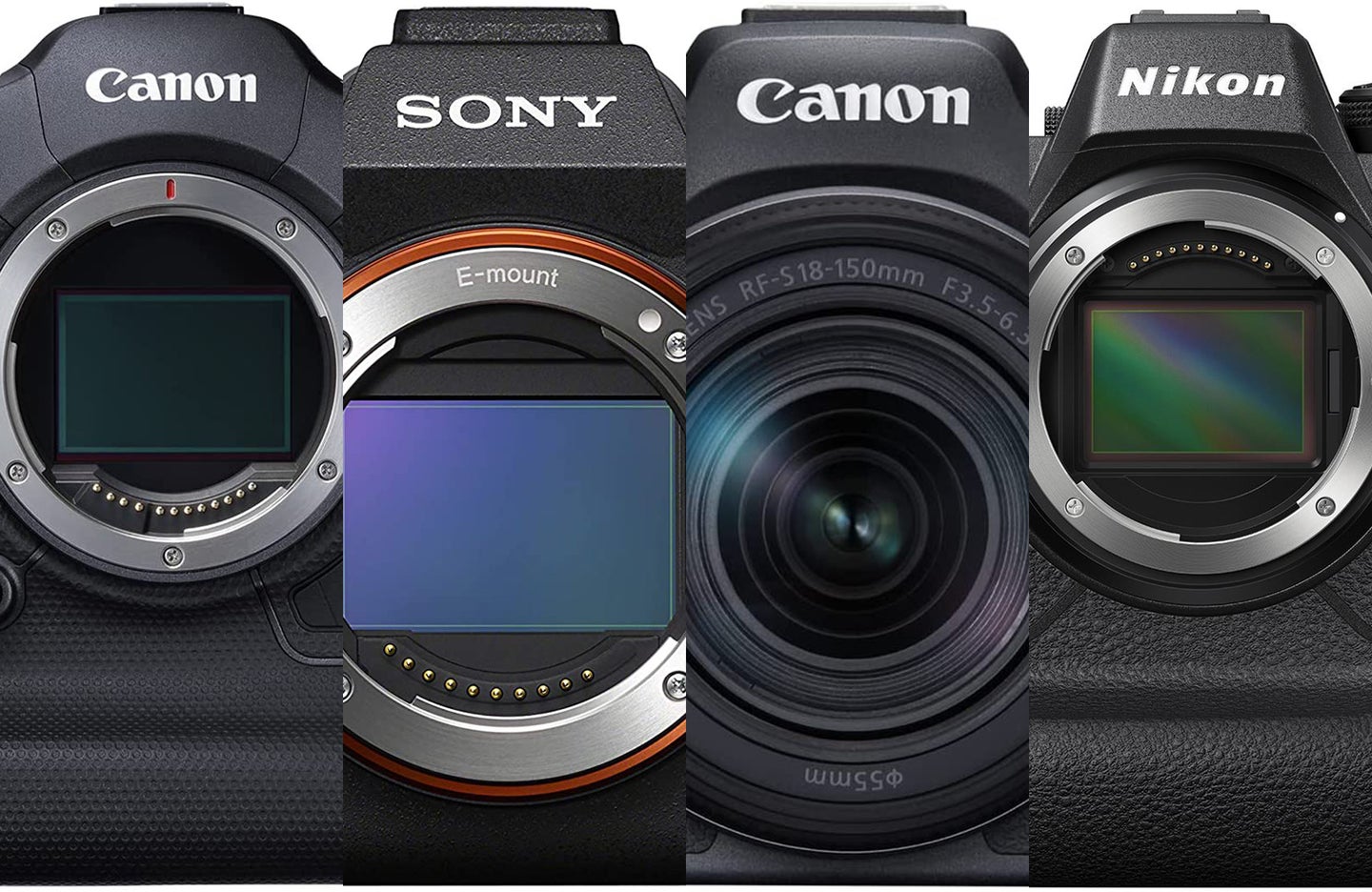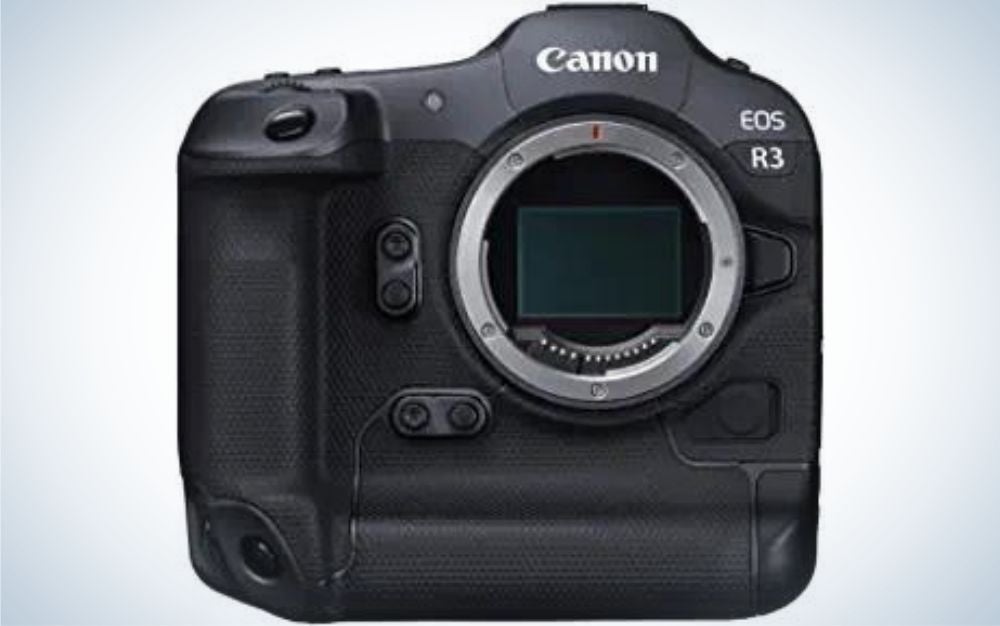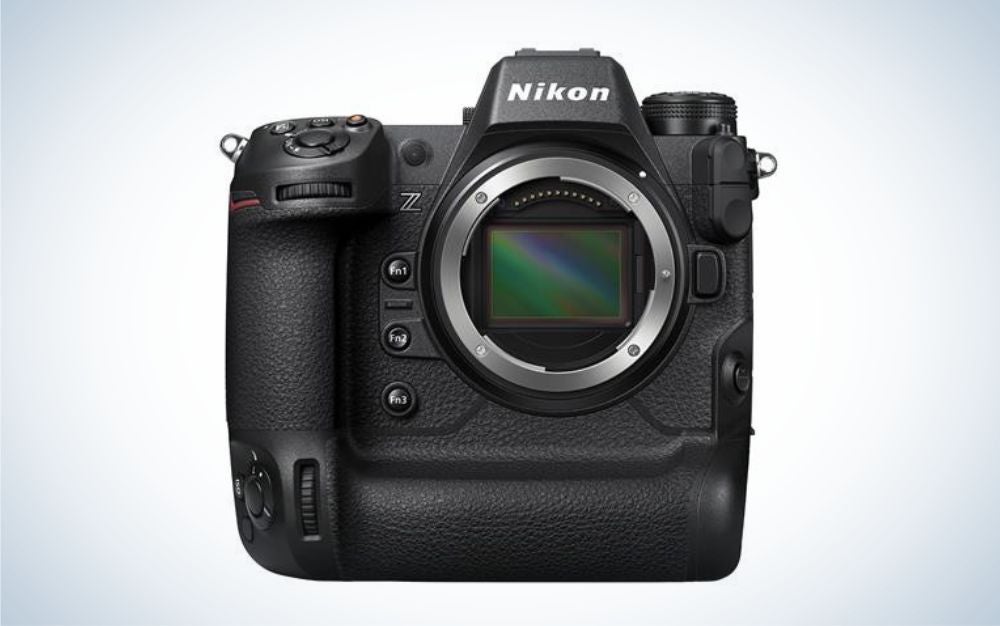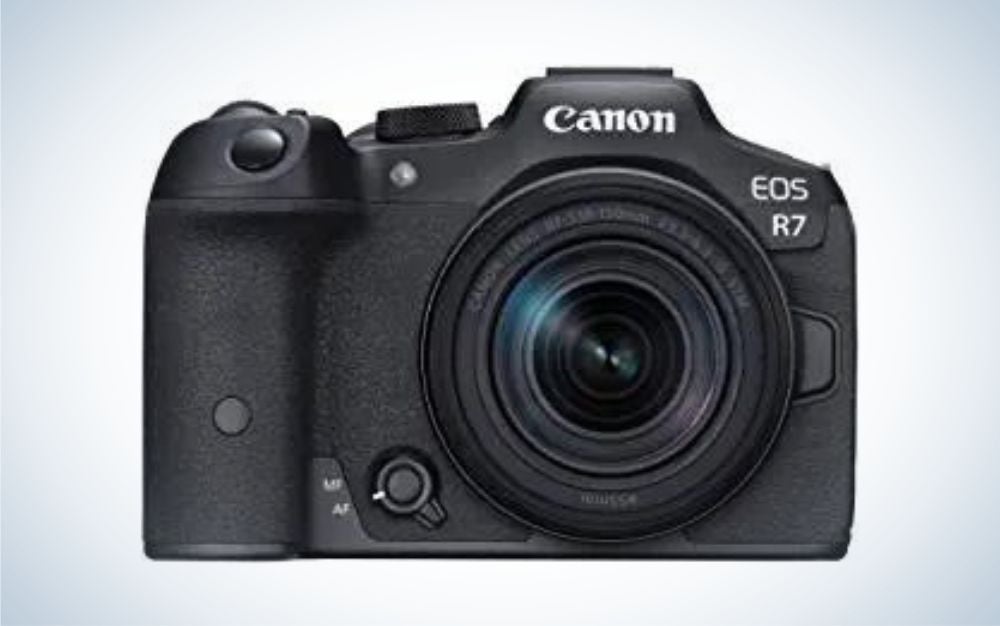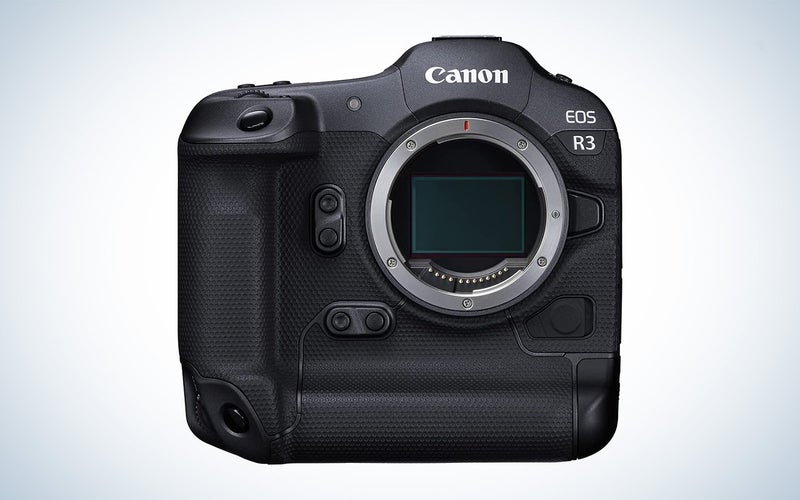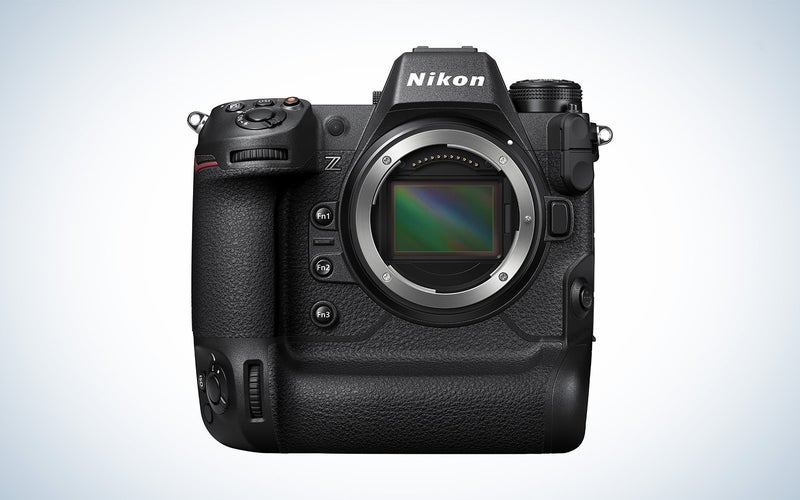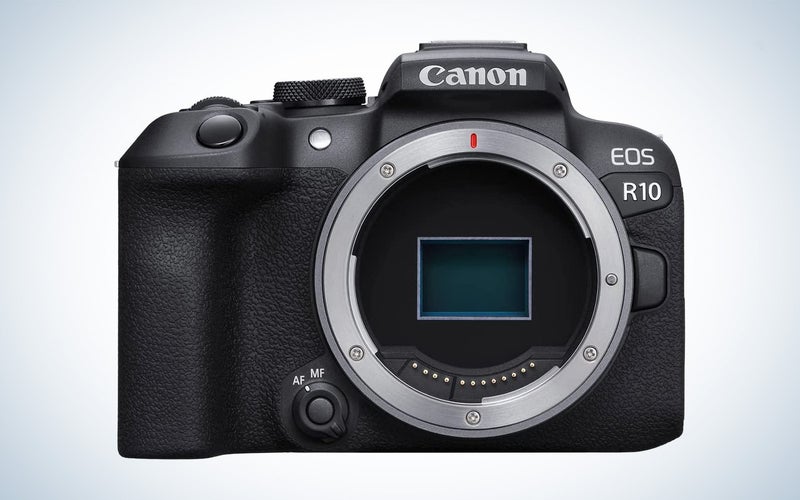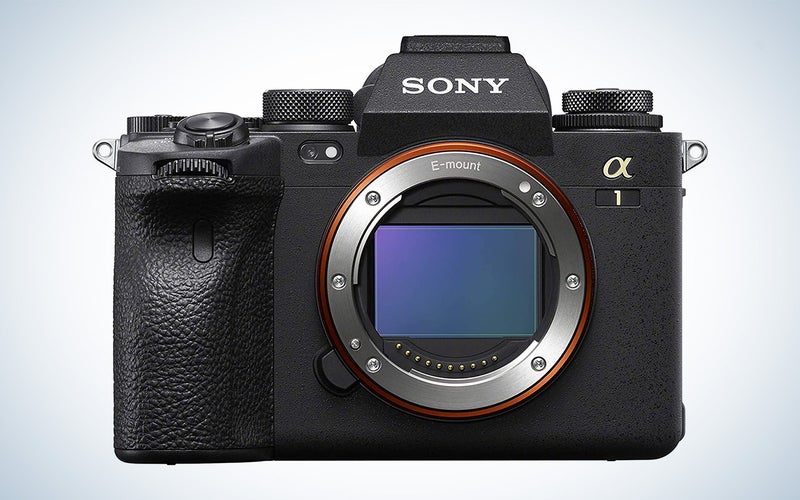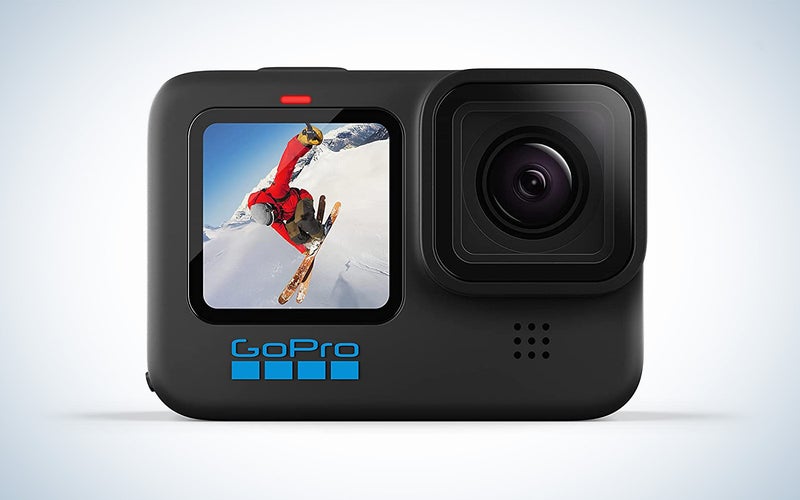We may earn revenue from the products available on this page and participate in affiliate programs. Learn more ›
Like high-level athletes, cameras for sports photography can achieve feats their more casual competition can’t. Sure, you can shoot sports with just about any camera. David Burnett has famously created incredible Olympic photos with an ancient large-format film camera. But, we can’t all be David Burnette. Some require high-end camera gear with impressive autofocus and blazing fast burst rates. Whether you’re on the sidelines of an NFL playoff game or a PeeWee football exhibition, the right camera can make a huge difference in the creative options at your disposal.
The best cameras for sports photography have the features and customizability you need to capture football, basketball, soccer, hockey, baseball, hot dog eating contests, or any other sport you’d find ESPN 3 playing in the middle of the night.
- Best overall: Canon R3
- Best Nikon: Nikon Z9
- Best budget: Canon R7
- Best Sony: Sony A1
- Best for action sports: GoPro HD Hero10
How we picked the best cameras for sports photography
I have been writing about and reviewing cameras since 2008, when I joined Popular Photography’s staff. Even before then, I had been working as a professional photographer covering everything from live music and editorial assignments to weddings and portraits. I’ve worked as a professional sports photographer in a number of capacities, many of which involve high-level Crossfit competitions. I’ve personally shot with all of the cameras in this list, many in sports settings.
For my picks, I’ve focused on bodies with fast burst rates, rugged builds, advanced autofocus functionality, and solid ergonomics.
Best cameras for sports photography: Reviews & Recommendations
Best overall: Canon R3
Canon
Why it made the cut: Its mix of meticulous autofocus, high burst speeds, and excellent ergonomics make this the go-to for shooting action.
Specs:
- Lens mount: Canon RF
- Sensor size: Full-frame
- Resolution: 24.1 megapixels
- Dimensions: 5.9 x 5.6 x 3.4 inches
- Weight: 35.8 ounces
Pros:
- Fantastic ergonomics
- Speedy AF with tons of customization options
- Large viewfinder
- Fast burst rates
- Solid battery life
Cons:
- Eye AF function may not be useful for everyone
I shot with a Canon 1D X II DSLR for years and honestly found it hard to imagine a mirrorless camera keeping up with it. The R3 really surprised me in the best possible way. With this body, Canon introduced a new 24.1-megapixel stacked sensor with super-fast readout speeds. That allows it to shoot up to 30 fps at full-res with the electronic shutter or up to 12 fps with the mechanical shutter.
Sports photography often requires high-ISO shooting, and the R3’s sensor has no problem reaching high numbers. I’ve gone as high as ISO 12,8000 and still gotten usable images out of it in tough situations. That’s partly due to the relatively low (at least for 2022) megapixel count.
The AF system offers several pages of configuration options. It can take a while to get the proper settings dialed in, but once you do, the tracking does a truly impressive job of keeping fast-moving objects in focus.
It’s a full-sized DSLR-style body, which means it has an integrated grip on the bottom with an extra shutter button for vertical shooting. Personally, I find the R3 is easily the most comfortable large camera I’ve ever held. And it feels particularly well-balanced when paired with a long lens.
Its relatively low megapixel count and bulk make it somewhat of a tough sell as an all-around camera, but for sports, it ticks all the boxes.
Best Nikon: Nikon Z9
Nikon
Why it made the cut: Nikon created one camera that can do anything, and that includes sports photography.
Specs:
- Lens mount: Nikon Z
- Sensor size: Full-frame
- Resolution: 45.7 megapixels
- Dimensions: 5.9 x 5.9 x 3.6 inches
- Weight: 47.3 ounces
Pros:
- Absurdly fast burst rates
- High resolution sensor for when you want more image data
- Very impressive AF tracking
- The most versatile screen on any camera
Cons:
- Big
- Heavy
The Nikon Z9 really is the camera that can do everything. The 45.7-megapixel sensor reads out at ridiculously high speeds, which enables still capture at up to 120 fps, the equivalent of a 4x slow-motion video. That mixture of fast shooting with high-resolution image capture is hard for any other camera on the market to match.
The camera completely lacks a mechanical shutter, which means all that speed comes with an entirely electronic shutter. That helps speed things up, but some sports photographers (myself included) prefer the sound and feel of a mechanical shutter in order to time shots. That’s not an option here.
The unique rotating screen offers more viewing angles than its competition, thanks to its ability to tilt both vertically and horizontally. That said, it’s a big, heavy camera that weighs roughly 12 ounces more than the Canon R3, which can be a factor during a long day of shooting.
Best budget: Canon R7
Canon
Why it made the cut: Canon took some of the R3’s autofocus smarts and put them in a camera with a much more affordable price.
Specs:
- Lens mount: Canon RF
- Sensor size: APS-C
- Resolution: 32.5 megapixels
- Dimensions: 5.20 x 3.56 x 3.61 inches
- Weight: 17 ounces
Pros:
- Autofocus system borrows from high-end bodies
- High resolution sensor
- Fast burst rates
- Much cheaper than pro-grade bodies
Cons:
- Enthusiast-grade weather proofing
Since the days of the original 7D, Canon has made excellent sports-oriented cameras at the $1,500 price point. The R7 continues that tradition. It’s one of the first APS-C bodies to come with Canon’s current RF lens mount, which means it’s compatible with the new and upcoming lenses.
The autofocus inside the R7 borrows heavily from more advanced cameras like the R5 and even the R3. The AF tracking is impressively accurate when it comes to finding and tracking subjects. The camera also offers several pages of AF options in the menu so you can dial in the performance for specific circumstances. For instance, you can tell it to lock onto subjects and ignore other objects that come into the frame. There’s a learning curve that you don’t typically see in a $1,500 camera, but it’s worth the effort to figure out.
Canon built an entirely new APS-C sensor to stick inside the R7, and it delivers very solid image quality. It won’t match the quality of the full-frame stuff (especially when it comes to shooting in low light), but it will effectively give your lenses a little more reach, thanks to the crop.
Best Sony: Sony A1
Sony
Why it made the cut: It has one of the fastest sensors we’ve ever seen inside, and that translates into real-world performance.
Specs:
- Lens mount: Sony E
- Sensor size: Full-frame
- Resolution: 50.1 megapixels
- Dimensions: 5.07 x 3.81 x 2.74 inches
- Weight: 26 ounces
Pros:
- The stacked, full-frame sensor reads out incredibly quickly
- Super-fast flash sync
- 30 fps shooting at 50 megapixels
- High-end video features
Cons:
- Expensive
- No built-in grip means less battery life than competition
Sony’s A1 doesn’t look much different from the other cameras in its A-series lineup, but it contains one of the fastest sensors ever to hit the market. It’s a stacked sensor, which means the computing hardware (including the signal processor and the DRAM) is integrated into the same silicon. That increases speed to cut down on unwanted effects like rolling shutter during video capture and temporary viewfinder blackout during image capture.
That fast sensor can pump out full-res images at up to 30 fps with the electronic shutter. It also enables impressive feats like flash sync at 1/400th second. That’s faster than most other cameras, which top out around 1/250th or even slower. It can really come in handy when shooting flash in bright conditions.
It’s not a full-sized pro camera in that it doesn’t have an integrated grip. That limits you to one battery, which won’t last as long as the cells in the Canon R3 or the Nikon Z9. But you can add a grip to it after the fact. The A1 is also the most expensive model on this list, but you’re paying for top-tier performance.
Best for action sports: GoPro HD Hero10 Black
GoPro
Why it made the cut: If you want a camera you can truly abuse, then the GoPro is a great option.
Specs:
- Lens mount: N/A
- Sensor size: N/A
- Resolution: 23 megapixels
- Dimensions: 2.79 x 2.16 x 1.32 inches
- Weight: 5.4 ounces
Pros:
- Unkillable when it comes to toughness
- Lots of great video features
- Easy control via app
- Raw capture
Cons:
- Image quality is just OK thanks to the small sensor
You may not think of the GoPro as a still photo camera, but it may surprise you with its chops. The HD Hero 10 Black easily mounts to just about any surface (or even human or animal) and can stand up to serious punishment. That makes it a great candidate for a remote camera you stick in harm’s way and then don’t worry about until the end of the shoot. It’s easy to control via the GoPro app, so you can trigger the shutter from afar.
The wide-angle main lens is sharp and captures detailed images, even if the angle of view may be somewhat limiting. Plus, it opens up options for all kinds of other photographic projects like epic time lapses.
Things to consider when shopping for the best cameras for sports photography
Sports photography is difficult. The subjects move fast and unpredictably, the settings are unforgiving, and you never know when an errant ball or player might smash into your gear. Choosing the right camera for sports photography will broaden your creative options.
Speed
When we think of sports cameras, we immediately picture shutters flapping wildly at high speeds. Burst mode is important for sports photography, but it’s not as simple as “faster is better.” The Nikon Z9, for instance, is extremely fast but lacks a mechanical shutter, which some sports shooters prefer to feel the timing of their shots. And if you’re shooting 60 full-res frames every second, you’re also going to fill up your memory cards and dig yourself a giant hole when it comes to editing. Ultimately, you want something fast but not absurd. 10-12 frames per second will work in most situations, but it’s nice to have access to 30 fps for particularly fast action or crucial moments where you need to hit peak action.
Resolution
Professional sports photographers don’t typically want super high-resolution images. They slow down the camera, eat up memory card space, and take longer to transmit to their editors. That’s part of what we like about the Canon R3. If you’re looking for a pure sports camera, you’ll probably never really need more than 24 megapixels of resolution. If you want a do-it-all camera, something like the Sony A1 or Nikon Z9 may fit your needs better.
Even high-res cameras typically offer lower-resolution capture modes, but that leaves the door open for situations in which you choose the wrong setting for a specific situation. I accidentally shot several player portraits in JPEG medium for a client because I was still set up for shooting and quickly delivering on-field images.
Autofocus
AF systems have gotten truly ridiculous in recent years. While DSLRs tend to focus very quickly, high-end mirrorless cameras offer AF tracking and customization that DSLRs can’t match.
All of the high-end and pro cameras have very fast and accurate AF, but I prefer Canon’s customization options compared to the competition.
Ergonomics
Most pro-grade sports cameras embrace the full-sized, DSLR-style bodies with integrated grips on the bottom. That gives you access to a bigger battery as well as an extra shutter button for shooting vertical images. The extra girth also helps balance out large lenses, which sports photographers often use. If you get a camera that doesn’t have an integrated grip, I recommend adding the grip later. It typically drastically extends battery life and sometimes even unlocks features in the camera that are unavailable without it, like faster burst rates.
FAQs
What camera do most sports photographers use?
This answer changed recently. Until just a few years ago, Canon 1D X Mark III and Nikon D6 DSLRs dominated pro sports photography. Now, you’ll still find those cameras in use, but high-end mirrorless bodies have taken a huge chunk of the marketplace. Pros typically use flagship bodies.
Can you buy refurbished cameras for sports photography?
You can absolutely buy refurbished cameras for sports photography. In fact, we recommend you do in many cases. Canon sells refurbished camera bodies and lenses itself. But, there are other online retailers that sell solid gear that’s worth a look.
Are DSLR cameras good for sports?
DSLRs were the standard for years before mirrorless cameras made a huge leap in their most recent generation. In fact, unless you’re buying a top-tier mirrorless camera, you’re probably still better off with a DSLR for shooting sports. DSLRs rely on dedicated phase detection autofocus sensors that typically snap into focus faster than comparable mirrorless cameras. Learning to shoot sports is slightly different with a DSLR than with mirrorless, but those mirror-toting cameras are still more than capable.
How many megapixels do you need for sports?
Unlike some other disciplines, too many megapixels can be a hindrance when it comes to sports. The 24-megapixel mark is solid, but more will also be fine. Just understand that you’re going to need many, many memory cards to hold all that image data. Even older DSLRs with 18-20-megapixel sensors are still plenty capable of pumping out fantastic images.
How much do cameras for sports photography cost?
If you want the same cameras pros are using, get ready to spend a lot of money. Flagship cameras typically fall between $5,000 and $6,500. That’s a lot, but these are also professional tools designed to take a ton of abuse in harsh situations. Cameras like Canon’s R7 only cost $1,500 (which is still a healthy sum of money) but provide some of the desirable features sports photographers want, like fast burst rates and AF tracking, at a much lower price.
Which is better for sports photography: DSLR or mirrorless?
If you have a ton of money to spend, then a pro-grade mirrorless camera is the way to go. If you’re looking at more consumer models, then there are still DSLR options out there that will perform better than their mirrorless counterparts. You can still find Canon 1D X II bodies on the secondary market for roughly a third the price of a flagship mirrorless camera.
A final thought about the best cameras for sports photography
Holding a camera on the sidelines of a sporting event is one of the most exciting and challenging ways to practice the craft. If you’re a serious enthusiast, aspiring pro, or full-blown professional, spending money to get a camera like the Canon R3, Nikon Z9, or Sony A1 will pay off in the long run. Or, you could start with something like the Canon R7. Whatever you pick, even the best camera for sports photography won’t make up for lots and lots of practice.
